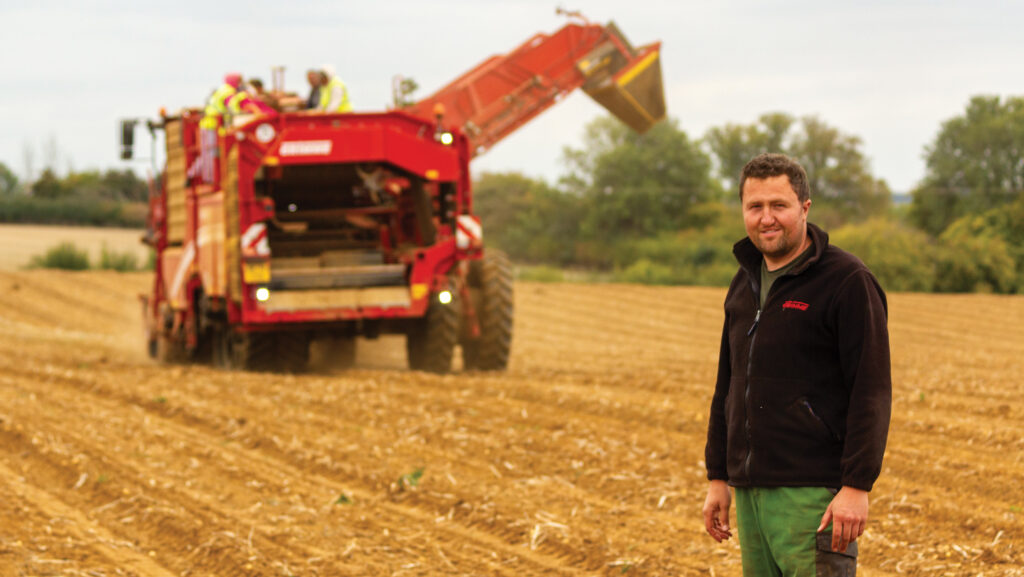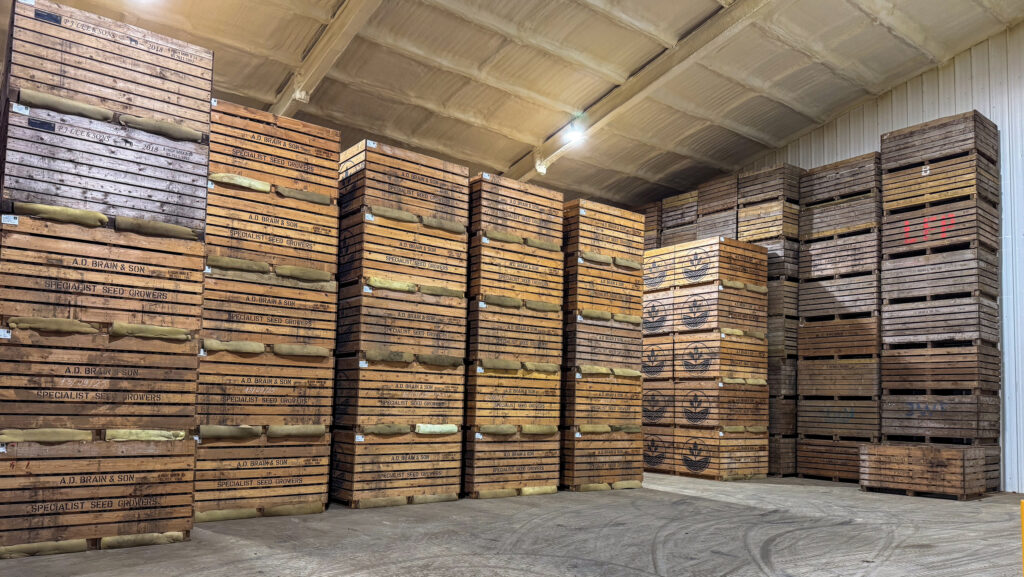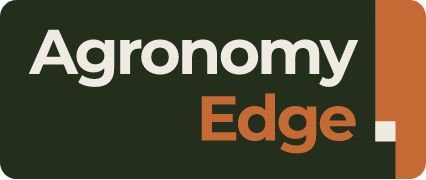How Cotswold potato grower produces high-quality seed
 Lifting potatoes at AD Brain and Son © Adam Clarke
Lifting potatoes at AD Brain and Son © Adam Clarke Specialist seed potato growers outside of well-known production areas in Scotland and Yorkshire are few and far between, but in many ways that’s what gives Jason Brain’s business its edge.
AD Brain & Son’s main yard sits 1,000ft above sea level.
It is situated on the highest point of the north Cotswold escarpment, a high limestone ridge which runs through Gloucestershire, Worcestershire, Oxfordshire and Warwickshire.
See also: Why leafhoppers are an emerging threat to potatoes
Farm facts
AD Brain & Son, Broadway, Worcestershire
- Area farmed 610ha (one-third owned, two-thirds rented)
- Crops Certified potato seed, winter and spring barley (for C1 for C2 seed), tenderstem broccoli, salad onions, pumpkins, hand-picked peas, Brussels sprouts
- Seed potato output About 5,500t annually
- Seed varieties Markies, Sagitta, Babylon, Lady Anna, Melody, Mozart, Maris Piper, Estima, Cardyma, Invictus
- Sales model Grower–merchant, 95% direct to ware growers offering full transparency and traceability for customers
- Cotswold seed potato facts High-altitude and isolation for minimal aphid pressure, older physiological age advantage for early ware crop
Ideal for seed
Across the outfit’s entire 610ha – part owned and part rented – elevation doesn’t drop below 800ft, making it ideal for the seed potato crops that account for about 25% of its arable area.
Jason, who runs the business alongside his father Ken, says this means less aphid movement and cooler (typically 2-3C) than the Vale temperatures, allowing for a kinder growing season reducing stress to the crop.
This also aids crop temperature pull down for storage with a traditional earlier harvest for seed crops (late August to September).
“There aren’t any other potato growers around us. The closest would be Tetbury in the south Cotswolds, about 40 miles and an hour’s drive away.
“Then heading west, it’s a similar distance and you’d be in Herefordshire. We’re very isolated, which is good for seed,” he explains.
The business hasn’t always grown potato seed, with Jason’s great-grandfather and grandfather originally market gardeners specialising in brassica production, ware potatoes, and running a flock of pedigree Suffolk sheep.
They quickly realised that the area’s thin, calcareous soils were not suitable for high-yielding ware crops, but were excellent for seed, which he initially sold to Cornish farms producing table potatoes for the early market.
Physiological age
These customers were attracted to another characteristic of seed grown further south.
Essentially, the warmer and brighter southern British climate speeds up the metabolic and developmental processes within the potato plant, giving progeny tubers an older physiological age.
When it comes to planting that seed, the subsequent ware crop emerges faster and matures quicker.
This can have significant advantages for the grower purchasing the stock.
Jason says back when the Cornish market was strong, growers using AD Brain & Son’s seed could get to harvest about 10 days earlier than those using Scottish seed.
Today, one of the farm’s main varieties is the late-maturing Markies.
If using seed from further north, you might lift Markies well into November, but seed with an older physiological age could pull it forward to October.
“That can make a big difference in a difficult autumn and it’s a big selling point for us.
“Once growers understand it and see the results, they really value what it brings,” notes Jason.
Growing philosophy
While the geographical and environmental advantages of growing seed in the Cotswolds are clear, Jason’s growing philosophy is also a significant part of the farm’s success.
There have been calls for seed potato production to be treated as a specialised, high-skill sector focused on crop health, traceability, and dedicated management, rather than a sideline to ware production.
Growing healthy, “dual-purpose” crops is becoming increasingly difficult due to lack of clean land and plant protection product (PPP) restrictions on potatoes destined for the human food chain.
This has resulted in AD Brain & Son focusing on maximising value from seed, having the sole aim of producing healthy, clean and high tuber numbers at the right size, typically between 30mm and 60mm.
Procuring the cleanest land is a significant part of this strategy, with about 95% of the farm’s potatoes planted into virgin land, and Jason says this has a significant impact on crop health.
It will be free of potato cyst nematode (PCN) and groundkeepers. Having not seen a potato crop before, risk of other pests and pathogens that might challenge crop growth and health is minimal.
“The reason there aren’t many potato growers around here is because most of the land isn’t suitable, so we do have to search hard for the right sites, which can be very time consuming,” he says.
Input seed
Quality of input seed is another important factor in crop health, and Jason sources most of his input stocks from the Black Isle in Scotland as pre-basic 2 (PB2).
Over two seasons, those PB2 stocks are multiplied to PB3 then FG4, which is the commercial grade he sells to his ware producing customers.
Just 5% of his seed is grown on contract, with the bulk sold via his own retail trade.
This makes the business a grower-merchant, selling direct, which Jason says is important for the commercial viability of his business, plus offers complete traceability and transparency to his customers.
“During the summer, between first and second Apha [Animal Plant Health Agency] inspections, many of them will come and walk the crops and they can see exactly what they’re getting.
“Today, growers increasingly want to know more: origin, physiological age, health, to give them confidence.
“The industry has got smaller and everyone that’s left is technically switched on and expects that level of detail. It’s had to become part of what we offer,” he explains.
Virus indexing
An example of that detail is routine test grading of all stocks to understand tuber counts and expected size fractions before final grading.
It is a time-consuming process – the team had about 35 different stocks to test for deliveries in spring 2025 – but it means customers have an accurate idea of what to expect and can feed that data into planting plans.
Another layer of information for customers is virus indexing, which isn’t yet part of the Seed Potato Certification Scheme (SPCS), but is under consideration by key industry bodies.
It has been well documented that virus levels in GB-certified seed have increased in recent seasons.
And Jason believes going the extra mile to show his seed stock is clean of virus gives customers confidence in his product.

Jason Brain © Adam Clarke
Post-burndown, pre-harvest samples of 120 tubers per stock are taken in a W pattern across the field and sent to the lab for testing.
“Back in 2018, people cut back on insecticides in a dry year, and we saw a lot of virus symptoms appear in ware crops, which made people much more aware of the issue.
“So now I try to answer the question before it’s asked. Customers expect transparency and we give them certification and virus indexing results before delivery,” he explains.
Control the controllables
Agronomy, including crop protection, is another critical part of the process.
Jason takes his strategic advice from independent potato specialist Denis Buckley and in-season guidance from Agrii adviser Kathryn Styan.
Their rules for seed production are simple: control the controllables.
In seed crops it’s particularly important to keep virus and late blight out so little is left to chance when the pressure is on.
But that doesn’t mean spraying for spraying’s sake.
Virus programmes are based on information from six yellow water traps across his potato area, which helps him react to what is happening on the ground.
“We haven’t used pyrethroids for several years and carefully target the use of mineral oils and insecticides like Tepekki (flonicamid) and InSyst (acetamiprid), when necessary.
“This year, we managed to get away with one Tepekki because aphid numbers were low.
“Some might say that’s a risk, but the proof is in our virus testing results, which came back clean,” he notes.
Blight programmes offer less wriggle room on frequency of sprays, but there is the opportunity to use more cost-effective products when pressure is low, like this year.
One problem that’s always addressed judiciously, though, is tuber blight caused by late blight zoospores. Protection is built into the programme from the get-go.
“Early use of products like Ranman Top (cyazofamid) and Infinto (fluopicolide + propamocarb) is key.
“If you get tuber blight in a seed crop, you’ve instantly lost its value.”
Nitrogen management
Nutrition is an area that has potential impacts across the growing season and all land destined for seed potatoes is tested for macro- and micronutrients, with programmes adjusted to each situation and variety.
The farm switched to liquid fertiliser placement in 2018, which has helped improved yields, particularly during drier seasons.
Jason says he’s also managed to rein in nitrogen rates over the years, with vigorous varieties such as Markies only receiving 50-60kg N/ha.
“It’s a delicate balance. We are aiming for tuber numbers, not haulm growth, so don’t want to encourage excessive foliage with too much nitrogen.
“We also don’t want crops to be too vigorous by desiccation time, so taper N to ease the crop off naturally, but without causing stress. Stress can bring disease risk.”
Crops are flailed after meticulous test digs – typically four per 5ha – which indicate optimum timing for yield and size fraction.
The remaining haulm and stems are then sprayed once or twice with a protoporphyrinogen oxidase inhibitor (PPO) desiccant, depending on the season.
“After desiccation we can often see 2t/ha of additional yield as tubers swell, so you must anticipate that.
“If you want that average 45mm seed size, you need to stop crops early.”
Tuber diseases
Harvesting, drying and curing are the final steps before they are safely in store, and this is where Jason makes one final treatment to keep tubers in top condition until spring.
His aim is to avoid handling the seed at all from the time it reaches the yard to final grading, as it risks physical damage which in turn increases risk of tuber diseases, namely fusarium dry rot and gangrene.
To minimise the risk of pathogens sneaking into nicks and cuts and spreading in store, he treats all stocks with Gavel (imazalil) through a specialist applicator.
“A few years ago, we had some issues with dry rot in a susceptible variety after harvesting in dry conditions, and it spread quickly.
“The cost of a rejected load was significant. We now apply it at harvest to all our varieties, and it wasn’t a difficult decision to make.
“It’s relatively cheap compared to the potential loss in value of seed, and since adopting that policy we haven’t had any issues at all,” explains Jason.

© Adam Clarke
Boxed seed is then placed on a drying wall for curing, for up to 72 hours, before finally settling into the farm’s ambient and cold stores, awaiting its one and only grade before spring delivery.
“At the end of the day, my business is only as good as the last load of seed that leaves the yard. Attention to detail at every step is everything,” says Jason.

